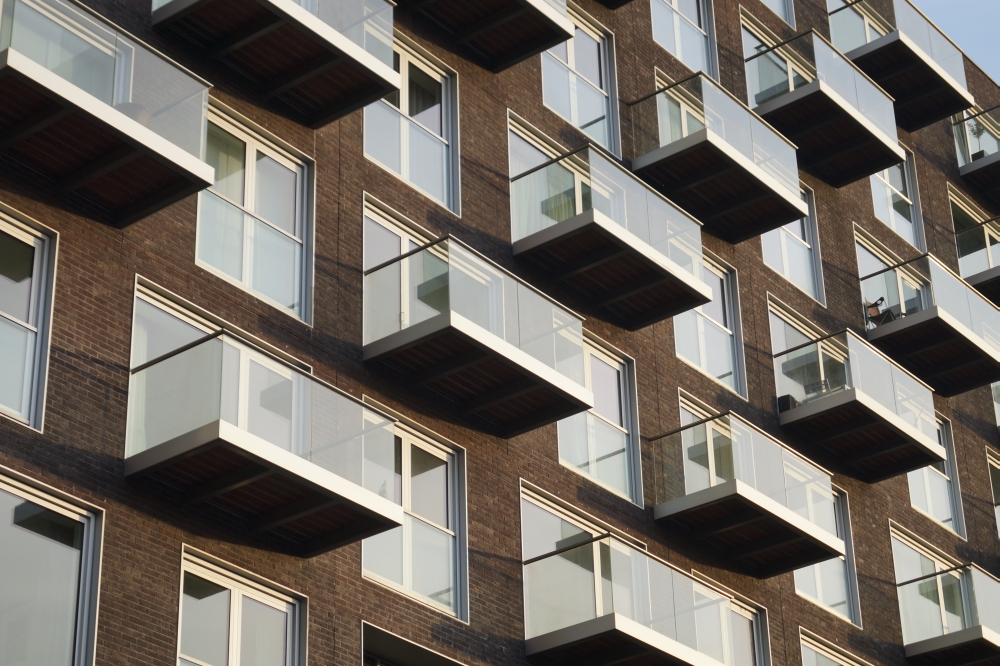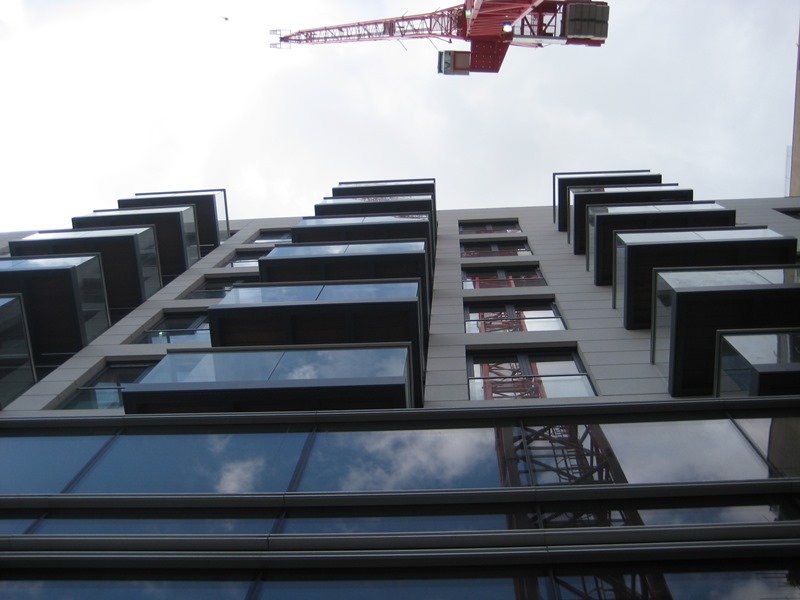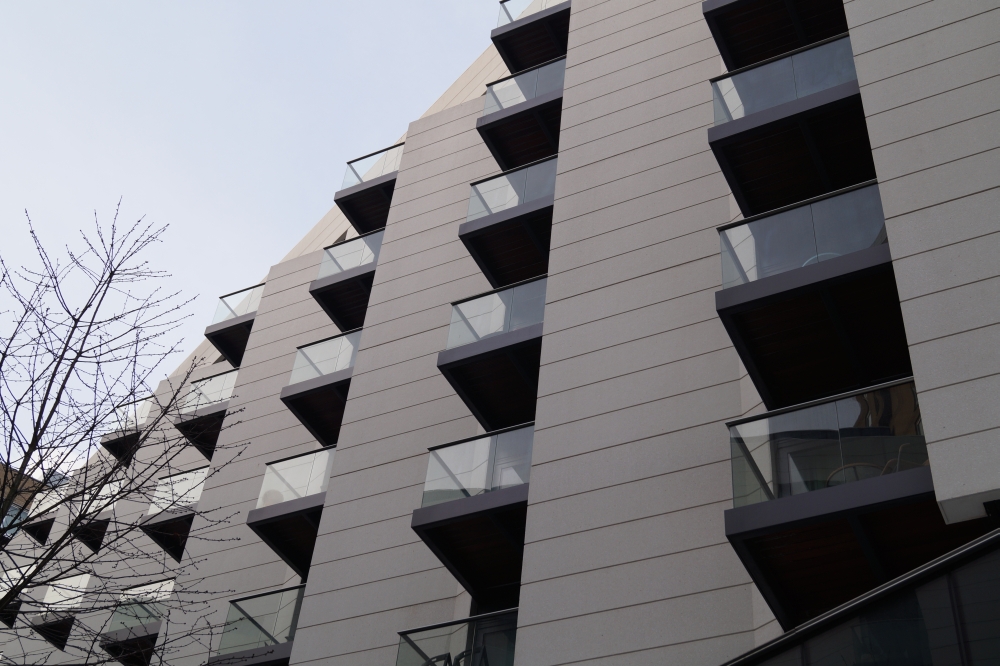Balcony Systems Solutions ltd developed a custom glass balustrade solution for 377 balconies, realising the architect’s original vision for this expansive project in addition to creating an amazing £500,000 saving on the original design.
Baltimore Wharf development in London’s docklands
 Clear glass balconies are a striking architectural design feature of the landmark Baltimore Wharf development in London’s docklands.
Clear glass balconies are a striking architectural design feature of the landmark Baltimore Wharf development in London’s docklands.
Breathing new life into the former London Arena site, Baltimore Wharf is an exciting and ambitious £150 million mixed development comprising private and affordable housing, retail, leisure and community facilities. Designed by architects Skidmore, Owings and Merrill Inc., it is among several significant construction projects in the Docklands area being undertaken by international developer, Ballymore Group.
Phase One of the Baltimore Wharf development, which includes more than 600 apartments in five separate residential blocks is constructed on the 6.8-acre former entertainment site, which is across the water from Ballymore’s 50-storey, neon-lit Pan Peninsula residential development.
As a key architectural feature of the buildings’ external facades, the design and installation of the external balconies required a particularly considered – and inventive – approach.
Working closely with the architect, developer and steelwork contractor, Balcony Systems developed an elliptical handrail and bottom rail system that has created a bespoke 21st century balustrade solution to suit the requirements of the multi-storey buildings and, just as importantly, the £3 million budget.
Balcony Systems also developed and supplied two unique extruded aluminium fascia profiles that finished off the edges of the balconies, one of
them being a 295mm wide extrusion. The designed system enabled a balcony system solution which included fra
The original design had called for a structural glass balustrade to be fitted on top of the steel balcony structure; this design required that the balcony steel be almost 300mm in depth.me cladding, decking and balustrade, delivered flat-packed, complete to site and ready to install.
Working with the developer, architect and steelwork contractor Balcony Systems offered a design that allowed the balconies to still be made with no vertical posts and yet create a system that is smaller in height, lighter in weight, clearer in glass colour and one that created a saving of £500,000 from the original design.
The hand-railing was designed to take the load to provide all the required strength and support and meet all the relevant Building Regulations. Utilising the handrail allowed the balustrade to span the required lengths without the need for vertical posts.
According to Effi Wolff, Managing Director at Balcony Systems Solutions ltd, the ability to meet the architect’s original balcony design criteria – to present a perfectly flat front fascia to seamlessly fit the main steel and the glazing track – was of fundamental
importance. A new aluminium handrail, finished in Royal Chrome to look like shiny stainless steel, and lower track extrusion was
specially designed for the Baltimore Wharf apartments. This allowed for relatively simple fitting to the main steelwork.
“Clear structural glass was originally specified. However our solution using toughened and laminated 9.5mm glass to retain a clear view, without the need for posts and at a very competitive price satisfied the key requirements for this prestigious project,” he says.
Feature fascia
“What is new about the system is that Balcony Systems has provided a flush-fitting anodised extruded aluminium feature fascia which provides a detail to match the main buildings’ window frames. This hides the steel balcony supports to present a neat front face to the structure.”
Effi suggests that what has made the design concept such a success was ‘going the extra mile’ to ensure that the original vision of the architect was maintained during the design period.
This was achieved through close collaboration with the architect, developer and steelwork contractor from the early planning stages to meet the challenges of making the design work with no posts and to keep the structure down to a minimum. Measuring 3 metres x 2 metres and 2.3 metres x 2 metres, the balconies did not require any posts.
stages to meet the challenges of making the design work with no posts and to keep the structure down to a minimum. Measuring 3 metres x 2 metres and 2.3 metres x 2 metres, the balconies did not require any posts.
An added advantage of the system – particularly for high-rise buildings – is that panel replacement, if needed, can be done quickly and safely from inside. Panels are supplied up to 1.2 metre in length for ease of transportation and installation.
Cost engineering through innovation
As well as supplying 377 balconies for the project, a cost effective design was realized for the social housing area of the development, replacing the wrought iron original design with a glass balustrade that met the budget.
In conclusion, Effi says: “Balcony Systems experience and ability to design new sections and adapt them to specific projects opens up a large expanse of design possibilities that can be realized. We like to get involved at the outset and can help drive the design to a meet the requirements but also be innovative and cost saving.”
Whether made of stone, wood or cast iron and now glass, balconies are an enduring and popular building feature that has been with us for centuries. Their design has continued to evolve to meet the changing face of architecture. The Baltimore Wharf project represents another step forward in the evolution of balcony design, taking it firmly into the 21st century.



